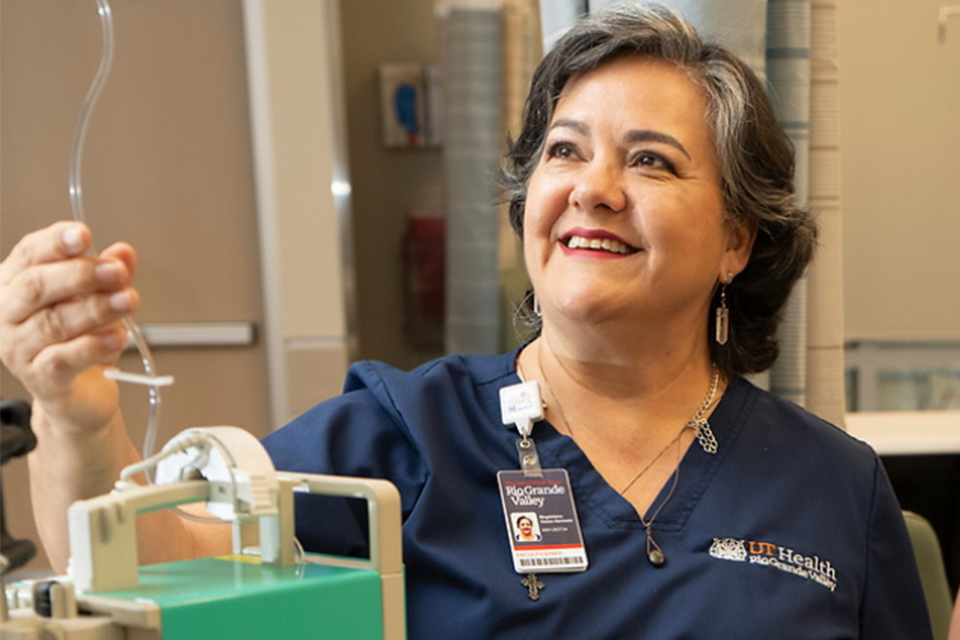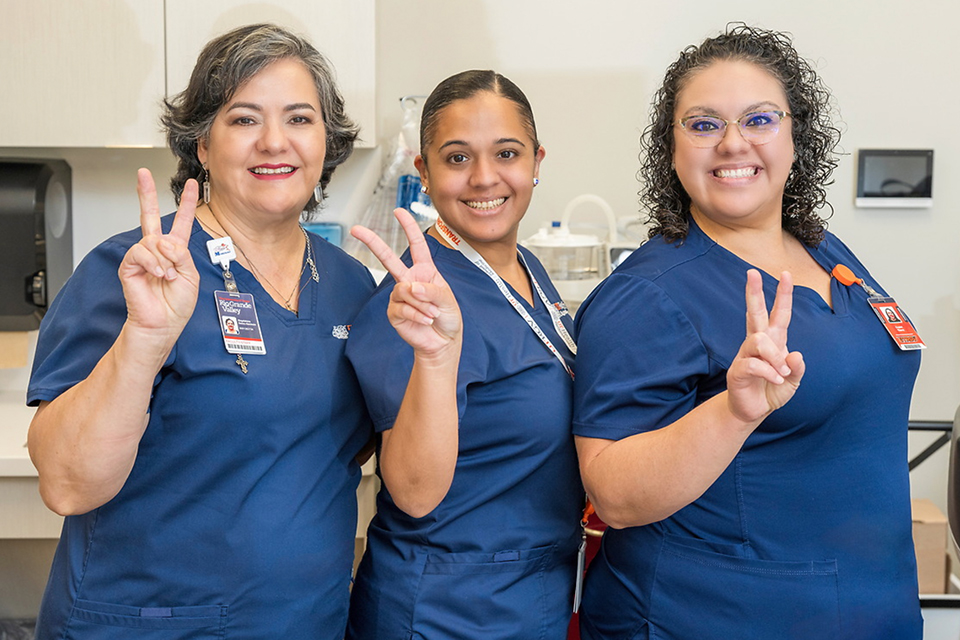
Magdalena Ostos-Germain, UT Health RGV’s first oncology nurse, relocated from Florida in 2022 to help prepare for the upcoming UT Health RGV Cancer and Surgery Center, set to support Valley cancer patients in 2025. (UTRGV Photo by David Pike)
News Release | Health

Magdalena Ostos-Germain, UT Health RGV’s first oncology nurse, relocated from Florida in 2022 to help prepare for the upcoming UT Health RGV Cancer and Surgery Center, set to support Valley cancer patients in 2025. (UTRGV Photo by David Pike)
Thursday, November 7, 2024
Alumni
By News and Internal Communications
RIO GRANDE VALLEY, TEXAS – NOV. 7, 2024 – UT Health RGV’s first oncology nurse, Magdalena Ostos-Germain, describes her 26 years of service to cancer patients as a gift.
“It's a blessing to be able to help others during the most stressful times of their lives – the people in bed, fighting for their lives against this ‘invisible giant,’” Ostos-Germain said. “These are your fellow human beings, and sometimes they’re people from your own community that you know.”
Some areas of the state face greater health disparities and disproportionate rates of certain cancers. Cervical cancer incidence and mortality rates are roughly 55 percent higher in the Rio Grande Valley than in the rest of the country. And, researchers at the UTRGV School of Medicine are investigating why Texas’ border areas have some of the highest rates of liver cancer in the country.
Ostos-Germain moved to the Valley from Florida in 2022 to prepare for the opening of the UT Health RGV Cancer and Surgery Center, which is set to start supporting the Valley’s cancer patients in 2025.
Being a nurse in this highly emotional field requires medical knowledge and skills, she said, but it also demands a compassionate personality.
“As a nurse, you are there to help patients and their families along the way – to hold their hands and make them comfortable through their treatment plan,” she said. “You have to be strong for your patients.”
STRONG AND SOFT FOR THE PATIENT
Ostos-Germain said oncology nurses monitor patients’ reactions to treatments and provide medications to relieve nausea, in addition to guiding them through the many questions that arise after speaking with their doctors. 
“You get to help by explaining what to expect – as many times as necessary – from day one of their treatment,” she said.
The process includes educating them about the medications they'll receive, the methods of delivery, the frequency of infusions or chemotherapy, and the duration of the treatments.
“We try to make the patient a part of the treatment, and we also meet their families and strive to make them comfortable, as well,” she said. “Every patient is different, and we encounter people from all careers and walks of life.”
It can be challenging for patients and their families to cope with the fear and anger that the fight against cancer entails, but nurses learn not to take it personally when patients need to vent their feelings.
“It’s not about us – it’s about what they’re going through,” she said. “But some patients can trigger so many emotions.”
Ostos-Germain recalls one patient and her 4-year-old daughter.
“She wanted to be a doctor when she grew up – to help her mommy. It was so touching,” she said.
Ostos-Germain gave the little girl a stethoscope to encourage her. Later, when attending the patient’s funeral – a habit of Ostos-Germain's – she saw that the little girl was wearing the stethoscope at the memorial service.
“It was difficult to see. I stopped going to funerals after that,” she said. “To protect yourself, you have to have the mentality that you are here to help, but it’s ultimately not up to you. Death is part of the life cycle.”
Reflecting on the transient nature of life helps Ostos-Germain appreciate the impact she can make every day by helping her patients any way she can.
“One day we will not be here, but you will live forever if you touch people's lives, and they remember you as part of them. That's the legacy we leave behind,” she said. “This life is difficult. But if we share the load with each other, sometimes it's not so heavy.”
A LIFE OF TOUCHING LIVES
Even before becoming a nurse, Ostos-Germain had always been caring for people. As the second oldest of her five siblings and 37 cousins, she was like a second mom to some of them. After her father died when she was young, she looked at careers that were in service to the public.
Although she really wanted to be a doctor, her family couldn’t afford medical school, so she left home at the age of 14 for Ciudad Victoria, Mexico, to study to be a teacher.
Working in rural communities, she shared the foundational knowledge she had with the mothers of her students. She remembers talking about nutrition and health while they embroidered or gardened together. And she vividly recalls the day she was called to help with a childbirth.
“Thankfully, the older women knew what to do. I just held a blanket,” she said. “I was scared because I had no idea how to help.”
After she met her husband, they moved to Florida. There, she entered the nursing field and fulfilled her lifelong desire for medical knowledge.
“Then, oncology chose me,” she said.
A scholarship from Florida Memorial Hospital offered the option of medical-surgical nursing – which she knew was not for her – or specialization on the oncology floor.
“I fell in love with it,” she said. “The patients are just different, somehow.”
Twenty-six years later, her dedication to them has only grown.

YOUR NEW FAVORITE ONCOLOGY NURSE
Despite the challenging emotions that come with caring for cancer patients, Ostos-Germain said, she enjoys the relationships oncology nursing allows her to form.
“You see the patients often, so they get to know you. They relax, and you get to be their favorite nurse,” she said.
And it is always rewarding when a former patient returns after finishing treatment to visit the nurses and their unit, she said.
“Nothing compares to the joy of seeing a patient go into remission. With all the treatments we have nowadays, a lot of patients do get better,” she said. “When they start recovering, it’s a wonderful thing. It’s like crossing the finish line in a race, and you get to celebrate with them.”
She can’t wait to celebrate those milestones with the Valley’s patients at the new UT Health RGV Cancer and Surgery Center, she said.
Until the new UTRGV center opens in 2025, Ostos-Germain has been helping patients with biotherapy and chemotherapy at the UTRGV Institute of Neuroscience (ION) in Harlingen.
Biotherapy involves using medication to stimulate the body’s naturally producing proteins or infusing the body with more of certain supplements, like iron and magnesium.
“It's like an army giving your body more soldiers to fight the cancer,” she said.
A UTRGV nurse was the first patient to start chemotherapy treatments at the ION. That nurse, and several other patients, shared with Ostos-Germain their financial and emotional burdens of traveling farther than the Valley for monthly treatment.
“The Valley has a few options, but patients sometimes have to wait for an appointment with an oncologist. If you’re diagnosed, you don’t want to wait months for treatment,” Ostos-Germain said. “Soon, UTRGV will be able to help them with that.”
ABOUT UTRGV
The University of Texas Rio Grande Valley (UTRGV) was created by the Texas Legislature in 2013 as the first major public university of the 21st century in Texas. This transformative initiative provided the opportunity to expand educational opportunities in the Rio Grande Valley, including a new School of Medicine and a School of Podiatry, and made it possible for residents of the region to benefit from the Permanent University Fund – a public endowment contributing support to the University of Texas System and other institutions.
UTRGV has campuses and off-campus research and teaching sites throughout the Rio Grande Valley including Brownsville (formerly The University of Texas at Brownsville campus), Edinburg (formerly The University of Texas-Pan American campus), Harlingen, Weslaco, McAllen, Port Isabel, Rio Grande City and South Padre Island. UTRGV, a comprehensive academic institution, enrolled its first class in the fall of 2015; the School of Medicine welcomed its first class in the summer of 2016, and the School of Podiatric Medicine in the fall of 2022.